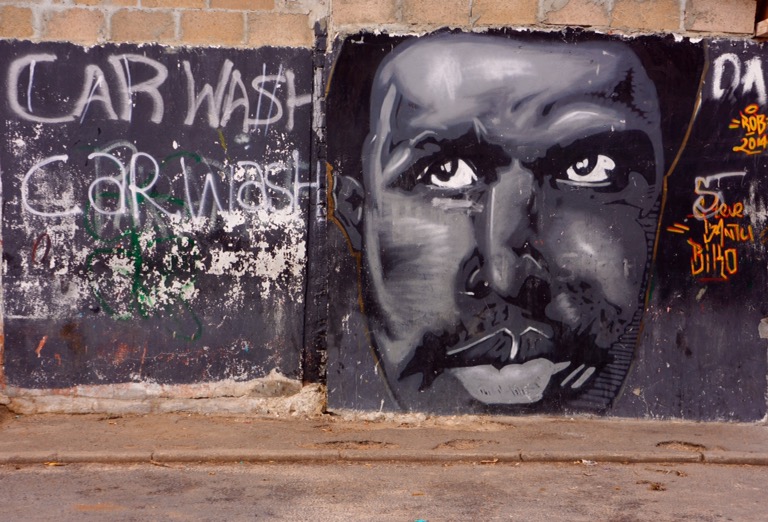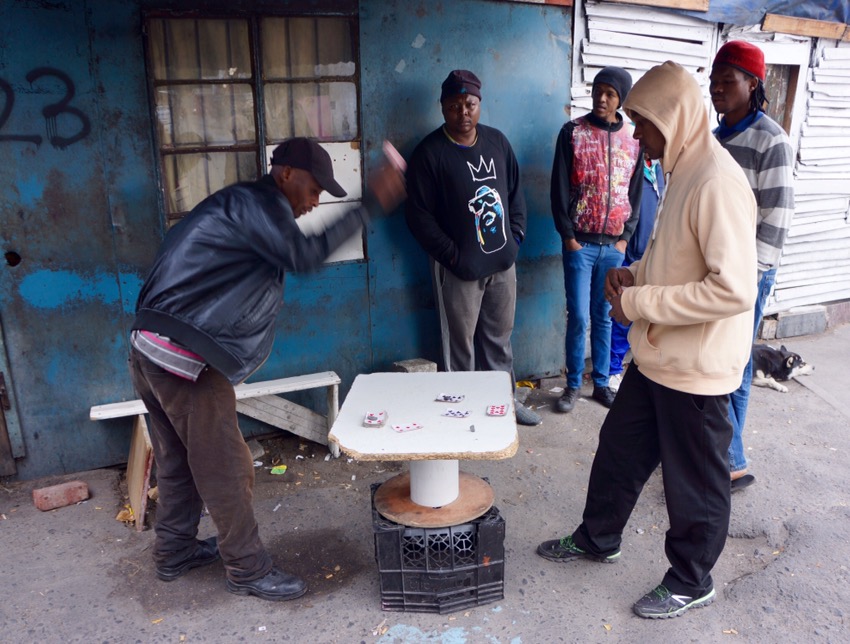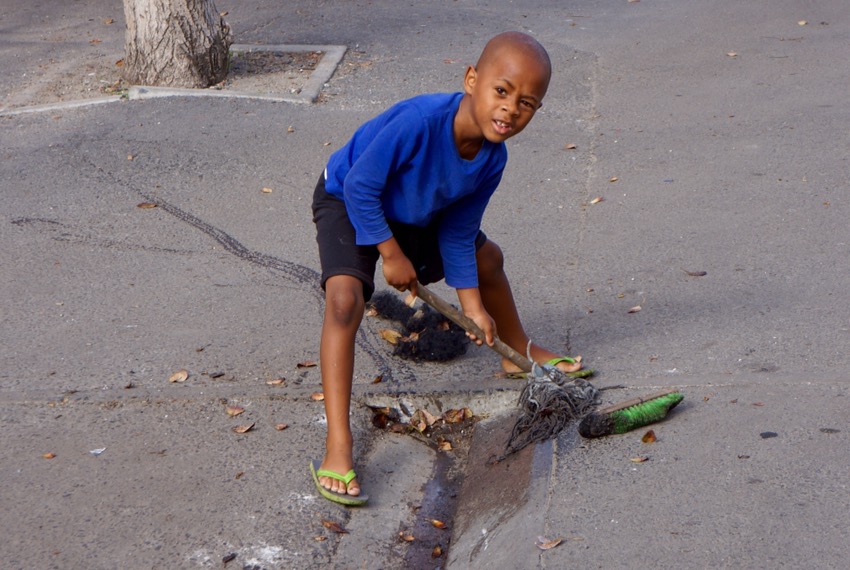May 12
“Cape Town has millions of people living in townships and today we take a tour to visit two of them, learn about their harsh past, witness the challenges they face every day, and learn about the positive hopes for the future.” That was the sentence from the itinerary prepared by our travel agent. In actuality, the township tour is sort of “township light,” emphasizing a couple centers of progress–fair enough–and virtually ignoring the realities of life. In fact, if I hadn’t insisted in a couple slow cruises through the shacks, innocuously described as “informal housing,” we almost would have missed them all together. When I asked about walking around, I was told it was “too dangerous.” We’d gotten much more accurate slices from other township or favela tours.
We were picked up at 9:00 a.m. by Godfrey, for a visit to Langa, the oldest formal black township in Cape Town. We see a crèche (nursery), which offers fun and a safe haven for the local children, and have the opportunity to join a drumming session with U Thando Arts at Guga’s Thebe. We also had the “opportunity” to buy some crafts, which we declined, making a small donation instead.
After Langa, we move on to Khayelitsha, one of the largest and fastest growing townships in Cape Town, for a visit at the art and crafts center and women’s cooperative, eKhaya eKasi. The cooperative supports a very worthwhile babies healt center set up by a Swedish doctor. Again we declined the opportunity to buy some things and made a contribution. There’s nothing wrong about offering these goods and a way to help the communities, and we did not feel pressure. Still in the absence of tastes of the harsher realities, it makes the trip seem more like a shopping trip (that’s definitely an overstatement). We stopped at a small hut–a pub–where I sipped locally-produced beer out of a big pail that was passed around to the other men.
In the afternoon, we drove the Gugulethu Seven Memorial, built to commemorate the death of seven young black activists from this township, and the Amy Biehl Memorial. Amy Biehl was an American Fulbright Scholarship exchange student, who was tragically killed in by black activists, who were convicted, and then later granted amnesty through the Truth and Reconciliation Commission.
Surprisingly, the most interesting aspect of our township tour was Godfrey, our 35-year old guide, who grew up and lives in Langa. He is a candidate for district councilor for the EFF (Economic Freedom Fighters), an opposition political party, formed several years ago that has grown enormously. We talked in detail about his goals, which all appear to be worthy community development, and his organizing efforts. There was a lot of energy around this discussion, and I told Godfrey that I was going to take over as his campaign manager. He has promised to keep us posted.
Here are some photos from the township.



















Carol and I had a real surprise treat for Zoe (and us) this evening. Thirteen years ago, when Carol and I travelled with friends of ours to South Africa, we had the pleasure of spending an evening with Justice Albie Sachs and his wife Vanessa September–drinks at their house, a speech Albie delivered and then dinner with them. Knowing we’d be in Cape Town, I managed to track Albie down, and we made arrangements to get together this evening.
Carol, Zoe and I spent an hour talking with Albie at his beautiful house that overlooks the ocean. Our discussions ranged to the many international matters he’s involved in in Colombia and other parts of the world. I was particularly interested opinion Colombia, having been there recently. He was not surprised to hear about the great skepticism I heard about the peace talks that are taking place in Cuba, which Albie has been a part of. He travels widely, lecturing and consulting, and is off tomorrow to give an address to a prestigious international organization in Toronto.
We went from his house to an art gallery in downtown Cape Coast that featured the work of the wife of the Spanish Ambassador, which Albie had been asked to open with some remarks. The work was interesting, incorporating newspaper accounts from around the world of South Africa’s struggle for freedom. Albie’s remarks were quite excellent, drawing on how Spain and Spanish poetry and music had influenced his life. After dinner, we were invited to join Albie, Vanessa, the Spanish ambassador and his wife and several other embassy and art gallery people for a delicious dinner at an Indian restaurant near the gallery. Vanessa was particularly delightful, sitting next to Zoe and engaging her fully in conversation. After dinner Vanessa and Albie drove us to our hotel. Below is a photo of Albie with the artist and a very poor photo of us with Albie and Vanessa–and the some biographical material on Albie.


Here, briefly is some autobiographical information about Albie. He was born in Johannesburg in 1935. His father, Emil Solomon (Solly) Sachs, had arrived in South Africa from Lithuania at the age of six, on the eve of the First World War, and his mother, Ray, had arrived as an infant. Both of his parents were involved in the Communist Party and trade unionism.
His career in human rights activism started in 1952 , when as a 17 year old second year law student at the University of Cape Town, he took part in the Defiance of Unjust Laws Campaign. Three years later, he attended the Congress of the People at Kliptown where the Freedom Charter was adopted. He began his practice as an advocate at the Cape Bar when he was 21, and most of his work involved defending people charged under apartheid’s racist statutes and repressive security laws. Many of the people he defended were facing the death sentence. As a result of his work, he was raided by the security police, subjected to banning orders restricting his movement and was placed in solitary confinement for 168 days without trial. He eventually went into exile in 1966.
He spent eleven years studying and teaching law in England, and a further eleven years in Mozambique working as a law professor and legal researcher. On 7 April 1988, a bomb that was placed in his car in Maputo (Mozambique) by South African security agents, blew up. He lost an arm and the sight of one eye.
In exile during the 1980’s, Sachs worked closely with Oliver Tambo, the leader of the African National Congress (ANC), and helped draft the organization’s Code of Conduct and statutes. After recovering from the effects of the bomb blast, he devoted himself full-time to preparations for a new democratic Constitution for South Africa. Finally, in 1990, he returned home. As a member of the Constitutional Committee and the National Executive Committee (NEC) of the ANC, he played an active role in the negotiations which led to South Africa becoming a constitutional democracy. After the first democratic election in 1994, he was appointed by then President Nelson Mandela to serve on the newly established Constitutional Court.
As a constitutional court judge, Justice Sachs was the chief architect of the post-apartheid constitution of 1996. As one of 11 green-robed judges, he participated in landmark rulings. These rulings included declaring capital punishment a violation of the right to life, to making it unconstitutional to prevent gay and lesbian people from marrying. The court also backed Aids campaigners in 2002, by insisting that the government had a duty to provide HIV-positive pregnant women with drugs to reduce the risk of transmission to their newborn babies.
In addition to his legal work, he has travelled to many countries sharing his experiences, in order to help heal divided societies. He has also been engaged in the sphere of art and architecture, and was involved with the development of the Constitutional Court building and its art collection (located on the site of the Old Fort Prison in Johannesburg). Sachs has also authored several books, including The Jail Diary of Albie Sachs (1966), which was published in Britain when he was a banned writer in South Africa. This book was later adapted by David Edgar as an RSC play in 1979, which is now a classic of prison memoirs. Stephanie on Trial followed his second detention, and The Soft Vengeance of a Freedom Fighter (1990) traced his triumphant convalescence after the bombing. He also wrote a book with Indres Naidoo, entitled Island in Chains. In 1991 he received the Alan Paton Award for Soft Vengeance of a Freedom Fighter.
Albie holds 14 honorary degrees across four continents In 2009 he received the Reconciliation Award as well as the Academy of Achievement Golden Plate Award. On 21 June 2014 he was awarded Taiwan’s inaugural Tang Prize in the Rule of Law for his contributions to human rights and justice globally In 2015 Albie was named a Ford Foundation Art of Change Fellow. He had helped select the art collection at Constitution Hill, the seat of the Constitutional Court.
Not exactly your ordinary tourist day in South Africa.

Wounderful! It sounds like you had a great (but very full) day!
Much love,
Awesome. Glad you had a great guide with lively conversation to help offset the somewhat disappointing tour.
Love to all,
W/M